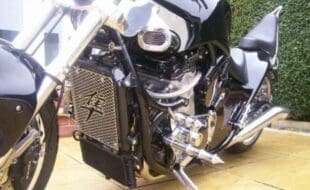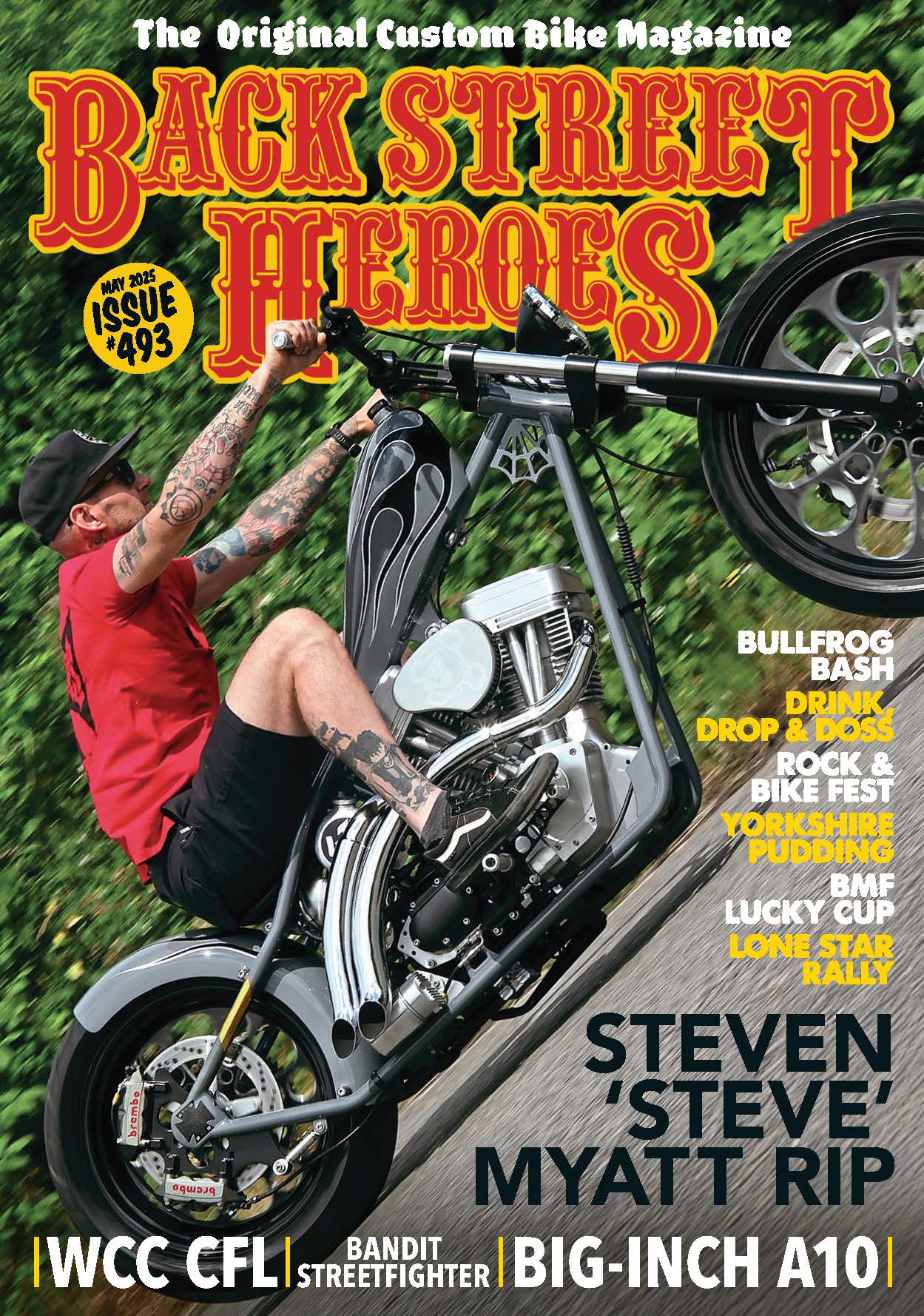In 2010, Donna Kilby, a lifelong biker, was in the unusual position, for her anyway, of being without a bike. As someone who’s totally addicted to them, and made her living breaking Japanese ones for parts, this really would not do. Words and pictures: Lawrence Howes
A trader offered her a 1984 Yamaha FJ1100; it had 70k on the clock, but seemed sound so she snapped it up. The first thing she did to personalise it was to paint a massive smiley face on the front and sides in yellow fluorescent paint, but other than that it was completely standard and she loved riding it. In fact, she rode it with so much élan that Andy, her other half, had to keep telling her to slow down!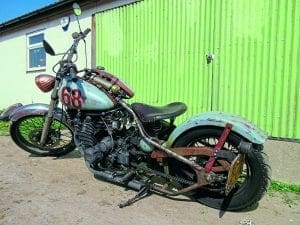
However, although she was enjoying the FJ as it was, she still hankered for something more custom, so when a friend at a custom shop offered her a frame they no longer wanted, she eagerly took it on. It’d been made by Dolin, a skilled artisan at the late lamented Revolution Motorcycles in Northampton, and she became friends with him, and together they stripped the FJ and built up the first version of this bike within just two months. It had a powdercoated black frame, a black stretched peanut petrol tank and copper fabrications all over.
Enjoy more Back Street Heros reading in the monthly magazine.
Click here to subscribe & save.
Once completed, she took the bike for its first MoT. On arrival, the MoT tester was not a happy bunny; as soon as he saw the hardtail, he hissed between his teeth, kicked it and poked it all over, looking for any possible weakness or potential failure point, tutting all the time as he did so. “This bike will kill you,” said he, then printed out an MoT certificate. Despite the tester’s dire prediction, it didn’t kill her, and she’s ridden many thousands of miles on it, and it’s passed every MoT since.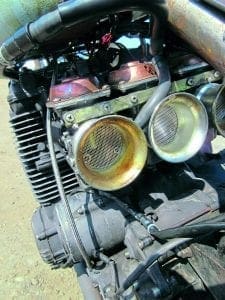
The chop was ridden as was for the next two years, but she was never 100% happy with it. It started to degrade and the petrol tank developed a weep, which turned into a gush out on a ride, but was cleverly fixed by Andy using a tube of Bostick; squeezing a ball of it into his hand, he rolled it between his palms until it formed a tight gummy ball, then smudged it into the crack. Miraculously the leak stopped and they were able to get home. This made Donna decide to completely rebuild the bike again. She’d always been amused by the Steampunk movement so decided to theme the bike as a ‘barn find’.
At a combined VW/bike rally her eye was caught by Rusty Paint (www.rustypaint.co.uk), and her bike would never look back. Rusty Paint is interesting stuff; it can be applied by brush or spray and goes on thick like an underseal. Then, once it’s dry, you rub it flat, apply an activator, and within a few hours nature starts doing the rest of the work, and you can sit back and watch your P&J age before your very eyes. When it’s as rusty as you wish, just wash it with soap and water, and the process stops. So impressed was Donna that she even painted the engine, and now at shows she gets a stream of people saying: “How can an aluminium engine go rusty?”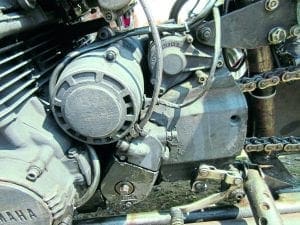
That engine carries no air filters as such and has exhausts with small discreet baffles, so it was Dynojetted to Stage 3 tune. (Air filters are being actively searched for, but getting ones with the right look to match the bike’s general déshabillé is proving difficult.) The exhaust was originally a straight-through four-into-four with two pipes running parallel to each other each side, but her ‘spirited’ cornering soon turned them into slash-cuts so they were remodelled into four-into-twos. Andy took the opportunity to fit small baffles, as riding behind he was worn out by the noise – the baffles were a tight, wedge fit, but as soon as Donna gave it a fistful they were blown out like rockets. The problem was solved by nipping the end off the pipe with a pipe cutter to give it an inward flange which nicely retains the errant quieteners.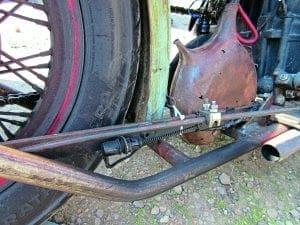
All the wiring was done by Donna, with help from Colin Loadsby, who she describes as an electrical genius, and she learnt very quickly not to wear any jewellery while doing it after her thumb ring arced with a battery terminal. The Yamaha ignition switch was swapped for an on/off key switch with a simple rocker switch to operate the starter motor, and herein lies a tale; for security, she always left the FJ parked in gear – all very well until the one time she turned the key to start it without knowing that the rocker switch’d been bumped into the ‘on’ position. Oops. The bike nearly demolished the garage wall…
She hand-painted the ‘68’ on the side of the tank; apparently, it’s an important year for her – perhaps her mum’s birth year, methinks? The things which’ve given the most pleasure during the build have been finding idiosyncratic items for the bike; the fire extinguisher on the tank is a favourite, closely followed by the World War One water bottle for the breather and the battery holder; another fire extinguisher! 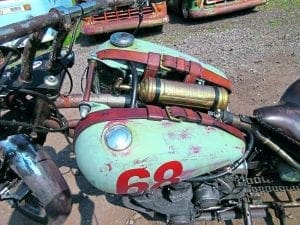 Lots of copper plating was carried out which gives the bike further antique patina. Clearly she’s succeeded in her ‘barn find’ quest. Many people tell her it’s lovely to see such a vintage bike in condition ‘as found’; “It’d be a shame to restore it,” they say…
Lots of copper plating was carried out which gives the bike further antique patina. Clearly she’s succeeded in her ‘barn find’ quest. Many people tell her it’s lovely to see such a vintage bike in condition ‘as found’; “It’d be a shame to restore it,” they say…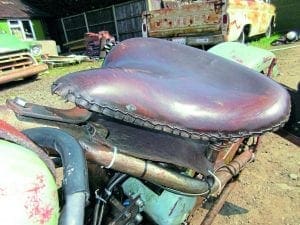
And the title of this piece? It’s what she calls the FJ; ‘The Chiropractor’ as it’s so comfortable to ride. While young she suffered a back injury in a horse riding accident, and her hip and spinal discs were damaged. The rat is the only bike she’s felt at ease on since; in fact it’s that good that, if she’s in pain, she goes out for a ride rather than grab some ibuprofen.



